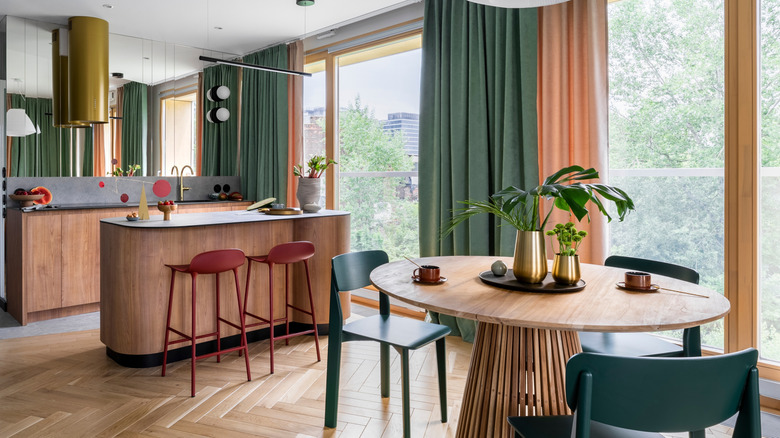How To Avoid A Common Mistake When Choosing The Right Color Green Curtains
Green curtains are endlessly versatile and can work with almost any style of decorating, allowing you to get the look you want, regardless of whether you're shopping for budget-friendly curtains or blowing the bank. However, if you don't consider the colors outside your window and the ones in the rest of your room, you could end up with a look that's 'meh' rather than amazing.
Avoid this mistake by analyzing all of the colors that surround your window. Green isn't a true neutral, but it does complement many other colors. You can see this in nature, where greenery of all shades forms a base for flowers of every hue. If your curtains surround a lush, green scene outside, consider choosing a vibrant, attention-getting shade such as chartreuse instead of a muted one that blends in with the natural elements. A brighter shade of green that pops will energize your surroundings.
Alternatively, if your window overlooks a gray urban cityscape, forest or fern green can provide a relaxing contrast by echoing the calm shades of nature. This can help your room feel like a soothing oasis, particularly if you continue the theme with a few houseplants, such as one of the many gorgeous spider plant varieties.
Using a color wheel to choose the perfect shade of green curtains
The color wheel is one of the most powerful tools in a designer's toolkit, as it organizes colors based on how they interact, and you can use it to find your perfect color palette. Complementary colors are opposites on the color wheel, and using both colors in your palette provides contrast and tension. It brings interest to a project, but it has the potential to be overwhelming. Green's complementary color is red.
On the other hand, analogous colors are beside each other on the color wheel. They blend well and don't compete with each other. Green's analogous colors are blue and yellow — the primary colors that combine to make it. Pairing an analogous color with green can give you an understated, tranquil effect.
Further refine your choice of color — or hue — by choosing a shade, tint, or tone. You create a shade by adding black to a hue, a tint by adding white, and a tone by adding gray. Any of these techniques will allow you to use your favorite hue without overwhelming your space. If you have your heart set on hanging chartreuse curtains next to your fire engine red rug, you can turn down the contrast but keep the hue by going with a tone. Shades and tints can also increase contrast and interest in analogous pairings. A light tint, such as seafoam green, will make your curtains pop against a darker shade, such as a navy wall. Understanding color theory empowers you to create a look you love by picking the green curtains that best harmonize with your space.

